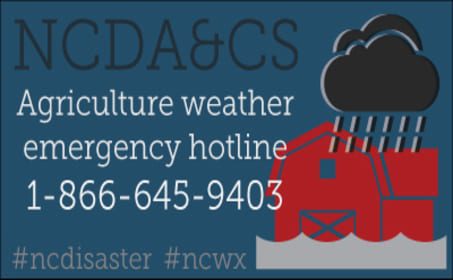With Hurricane Matthew looking more certain to affect North Carolina, Agriculture Commissioner Steve Troxler is urging farmers to have emergency plans in place for their farms and share those plans with workers in advance of landfall.
Many crops are still in the field and recent rains from tropical storms have saturated parts of eastern North Carolina, said Troxler. “This creates a perfect condition for downed trees, flooded pastures and crops lost in the field. But farmers can take some steps ahead of time to minimize losses or at least be prepared to respond after the storm.”
Troxler says farmers should review their farm emergency plan, which includes having a list of emergency contacts of whom to call after a storm. Farmers should include the county emergency management office to their list of important numbers.
“Every farming operation is different and has different needs. Assessing in advance what your most pressing needs will be if you should lose power, or are at risk for flooding, can be the difference in salvaging a crop or saving livestock,” Troxler said.
Gov. Pat McCrory signed a disaster declaration Monday that waived restrictions on vehicle weights for farmers preparing for the storm to move feed, crops or livestock in 66 central and eastern counties.
Previous storms have shown that backup generators are in high demand following storms, and on-site feeding capabilities for livestock operations are also critical.
“The need for generators is always high when a storm strikes,” Troxler said. “We encourage farmers to contact local farm suppliers and rental companies in advance of storms to reserve a generator on their own in the event of power outages.”
Troxler reminded farmers that they should have a transfer switch properly installed ahead of time so they can use a generator. A properly installed transfer switch is critical for the protection of farm facilities and utility workers, he said.
In addition, pesticide applicators should look to secure their pesticide storage areas. Applicators in low-lying areas should do whatever they can to elevate or move pesticides to locations that are less likely to flood.
More preparedness tips to consider:
- Review insurance policies to be sure your farm is properly covered.
- Clear ditches so that water can move freely.
- Check power line clearance to see if trees need pruning or removing
- Closely monitor local weather reports for up-to-the-minute information on storms.
- Fuel up all vehicles and prepare your family’s disaster readiness kit. Don’t forget household pets.
- Keep all electronic devices charged.
- Store or secure items or equipment that might blow away.
- Relocate livestock and animals from low-lying areas.
- Check generators to be sure they are in good working order and secure a sufficient amount of fuel to operate them.
- Secure propane tanks to prevent them from floating away. Turn off the propane supply at tanks.
- Move equipment to the highest open ground possible away from trees or buildings that could cause damage.
- Mark animals with an identifier so they can be easily returned if lost. Examples are ear tags with name of farm and phone numbers, brands, paint markings on hooves or coat or clipped initials in the hair.
- Move feed to higher ground or to a more accessible place in case of flooding or transportation problems.
- Secure or move pesticides to higher ground in the event of flooding.
- Coordinate with neighbors beforehand and discuss what resources can be shared.
- On social media, follow the National Weather Service @NWSRaleigh, NCDA&CS @ncagriculture, and N.C. Emergency Management @NCEmergency. Government officials will use #MatthewNC on social media channels to get word out about the storm as well.
More tips and information can be found at www.ncagr.gov/disaster.
